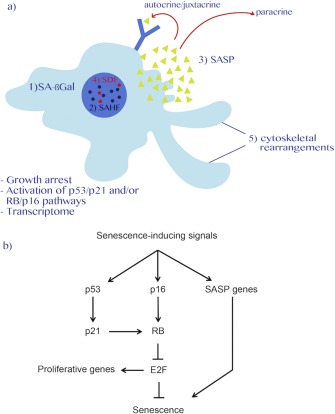Figure 1.

Biomarkers of senescence. (a) Senescence is a stable growth arrest that is orchestrated by the p53/p21 and/or RB/p16 tumor suppressor pathways. Biomarkers of the senescence phenotype may include: 1) increased senescence‐associated β‐galactosidase activity (SA‐βGal); 2) reorganization of chromatin architecture as exemplified by senescence‐associated heterochromatic foci (SAHF) and reflected by a dramatic change in gene expression profile; 3) acquisition of a senescence‐associated secretory phenotype (SASP) that can enforce senescence in autocrine/juxtacrine and paracrine fashion (arrows); 4) constitutive senescence‐associated DNA damage foci (SDF); and 5) extensive cytoskeletal rearrangements characterized by a flat cell morphology. (b) Schematic representation of the two major senescence‐effector pathways (i.e., p53/p21 and RB/p16). Several senescence‐inducing stimuli such as hyperactivated oncogenes, DNA damage, cytokines, and therapeutic agents can activate these pathways to induce senescence.
